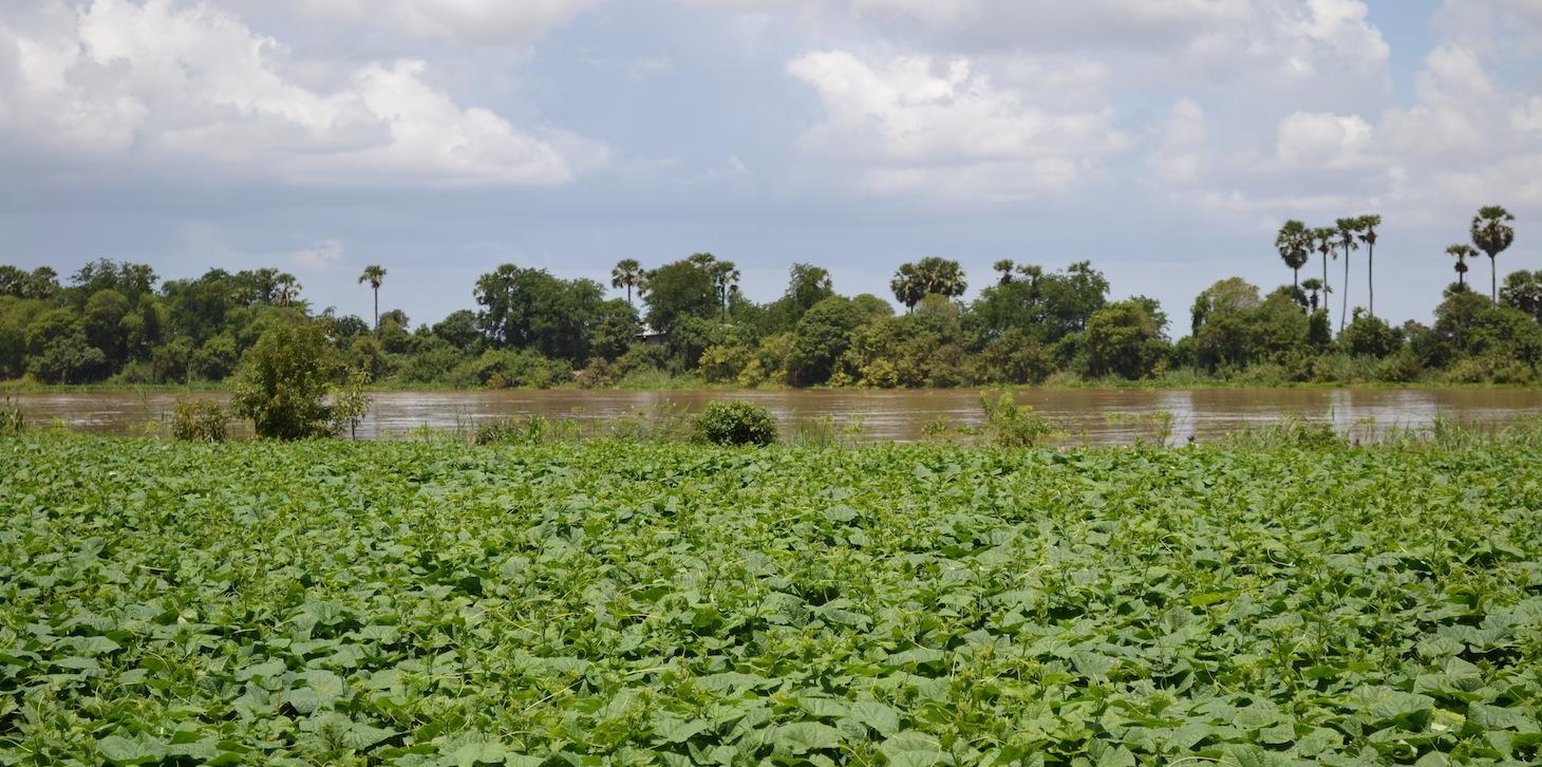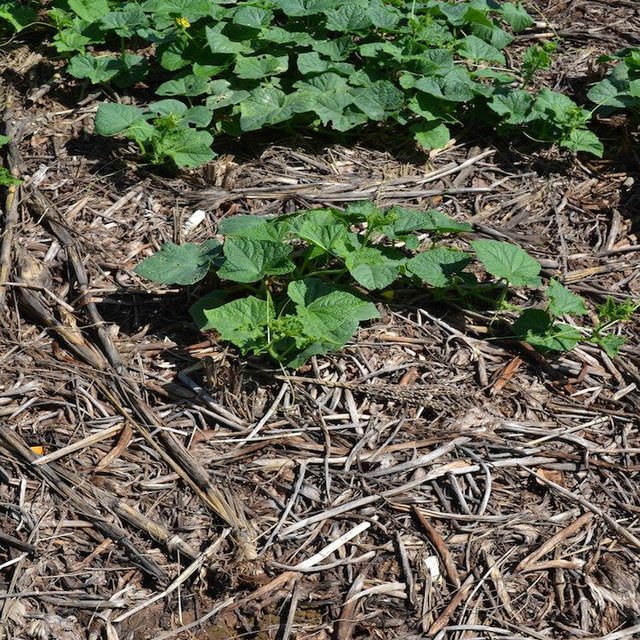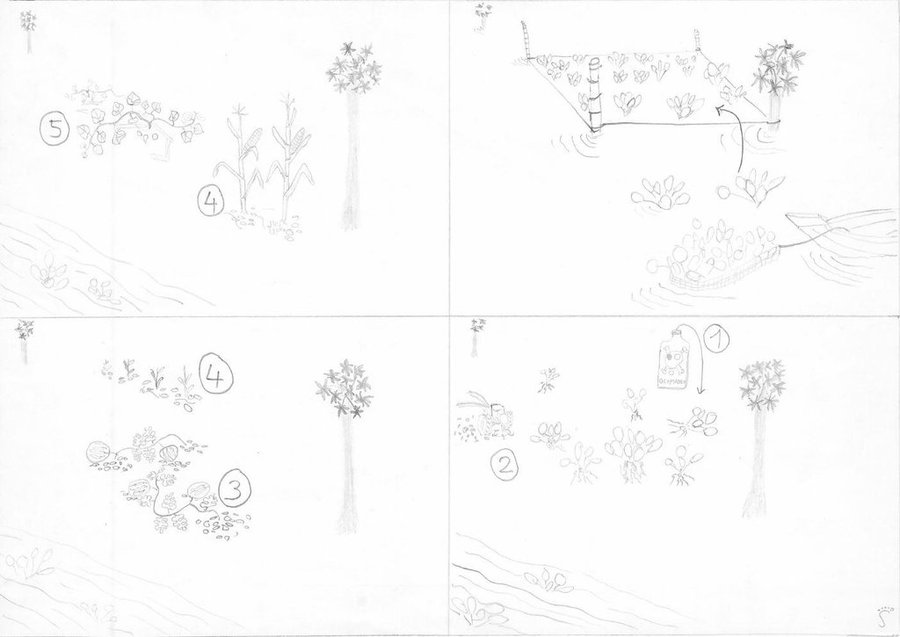



This mulching technique is used at the riverside of the Tonle Sap River. The area is flooded during the late rainy season (September to November), and alluvial mud is deposed on the fields, which enhances the soil fertility. The deposition of sediments depends on the extent of the yearly flood, and is threatened by the construction of hydropower dams on the upper Mekong River (Thomas et al. 2012:49), as well as climate change (floods tend to be smaller or more extreme). During the dry season (approximately from January to June, depending on precipitation patterns) the land dries and due to high temperatures and very low precipitations, crops can be harmed.
At first, the farmer gathers the water hyacinth with his boat during the wet season. He surrounds them with a net and pulls them to his fields, where he prepares fences with bamboo poles and iron wires. He fills the fenced area with the water hyacinth. Once the water recedes, he sprays glyphosate on the water hyacinths and chops them by using a hand tractor. He plants his first crop, watermelon, as soon as the soil is dry enough (start of dry season). The crop residues of the watermelon are left on the fields, and he can plant a crop of corn and a crop of cucumber before the next flood enters.
The analyzed area is flat (slope < 2%), tropic (dry and wet season), and the soils are mostly loamy. The groundwater table is rather high with 1-2 m during the dry season (November to May). The area is flooded during and after the wet season (August-September to November). The floods bring sludge and thus nutrients to the fields.
Due to climate change, the rainfalls are more erratic, temperatures rise and droughts are more recurrent. Chili is the cash crop predominantly grown in the flooded area, with floating rice as second crop.
Agricultural activity in this region is confronted with high migration rates (garment industry, cities, or other countries). This is detrimental for the farmers, since there is less labour force available. Also, the presented technology requires a rather high initial investment (especially when a tractor is bought) and an increase of physically strenuous labour. Therefore, the interviewed land user stated that most farmers are reluctant to do high investments on their farm. This is aggravated due to the fact that taking up credits might increase the dependency of the farmer.
ទីតាំង: Kampong Os, Kampong Chhnang, ប្រទេសកម្ពុជា
ចំនួនទីកន្លែងបច្ចេកទេស ដែលវិភាគ:
ការសាយភាយនៃបច្ចេកទេស: ត្រូវបានផ្សព្វផ្សាយត្រឹមតំបន់មួយ (0.02 km²)
តើស្ថិតក្នុងតំបន់ការពារអចិន្ត្រៃយ៍?:
កាលបរិច្ឆេទនៃការអនុវត្ត: តិចជាង 10ឆ្នាំមុន (ថ្មី)
ប្រភេទនៃការណែនាំឱ្យអនុវត្តន៍៖






| បញ្ជាក់ពីធាតុចូល | ឯកតា | បរិមាណ | ថ្លៃដើមក្នុងមួយឯកតា (មិនមាន) | ថ្លៃធាតុចូលសរុប (មិនមាន) | % នៃថ្លៃដើមដែលចំណាយដោយអ្នកប្រើប្រាស់ដី |
| សម្ភារៈ | |||||
| tools | ha | 1,0 | 130,0 | 130,0 | 100,0 |
| boat | ha | 1,0 | 1000,0 | 1000,0 | 100,0 |
| hand tractor | ha | 1,0 | 1500,0 | 1500,0 | 100,0 |
| ជី និងសារធាតុពុល | |||||
| biocides | ha | 1,0 | 4,5 | 4,5 | 100,0 |
| សម្ភារៈសាងសង់ | |||||
| wires and bamboo poles | ha | 1,0 | 30,0 | 30,0 | 100,0 |
| ថ្លៃដើមសរុបក្នុងការបង្កើតបច្ចេកទេស | 2'664.5 | ||||
| ថ្លៃដើមសរុបក្នុងការបង្កើតបច្ចេកទេសគិតជាដុល្លារ | 2'664.5 | ||||
| បញ្ជាក់ពីធាតុចូល | ឯកតា | បរិមាណ | ថ្លៃដើមក្នុងមួយឯកតា (មិនមាន) | ថ្លៃធាតុចូលសរុប (មិនមាន) | % នៃថ្លៃដើមដែលចំណាយដោយអ្នកប្រើប្រាស់ដី |
| កម្លាំងពលកម្ម | |||||
| labour | ha | 1,0 | 35,0 | 35,0 | 100,0 |
| សម្ភារៈ | |||||
| machine use | ha | 1,0 | 10,0 | 10,0 | 100,0 |
| ថ្លៃដើមសរុបសម្រាប់ការថែទាំដំណាំតាមបច្ចេកទេស | 45.0 | ||||
| ថ្លៃដើមសរុបសម្រាប់ការថែទាំដំណាំតាមបច្ចេកទេសគិតជាដុល្លារ | 45.0 | ||||
គុណភាពមុន SLM: 50
គុណភាពក្រោយ SLM: 100
According to the farmer the yield doubled.
Grows other cash crops than the other farmers in the area.
However, there is less irrigation work needed.
Herbicide is used in the river.
Problems with insects
Herbicide goes into the river